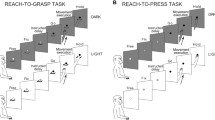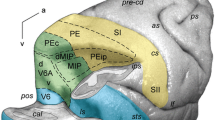Summary
Neurons in the arm areas of the external and internal segments of the globus pallidus (GPe and GPi) and the ventral pallidum (VP) have been examined in a visuomotor step-tracking task. This task, which was similar to that used previously to examine neurons in the arm area of the putamen, dissociated the direction of movement from the pattern of muscle activity associated with the movement. The major finding of the present study is that, as in the putamen, the activity of almost half of the neurons in GPe and GPi was related to the direction of movement. Cells with overall patterns of activity similar to muscle were rare, although many neurons had static and/or dynamic load effects which resembled those seen in muscle. Responses of neurons to load application have also been examined in this paradigm in order to determine the nature of possible somatosensory input. Short-latency “sensory” responses to load application were found in pallidum as previously in putamen, but, by contrast, they occurred somewhat later and included bidirectional responses. Similar proportions of cells in GP and putamen were related to static loads. Some VP neurons appeared to encode information about specific features of the trials, but the majority of responses were nonspecific suggesting relations to more general features of the task.
Similar content being viewed by others
References
Alexander GE, DeLong MR, Strick PL (1986) Parallel organization of functionally segregated circuits linking basal ganglia and cortex. Ann Rev Neurosci 9: 357–381
Allum JHJ, Anner-Baratti REC, Hepp-Reymond MC (1983) Activity of neurons in the motor thalamus and globus pallidus during the control of isometric finger force in the monkey. In: Paillard MJ, Schultz W, Wiesendanger M (eds) Neural coding of motor performance. Exp Brain Res Suppl 7 Springer, New York, pp 194–203
Anderson ME, Horak FB (1985) Influence of the globus pallidus on arm movements in monkeys. III. Timing of movement-related information. J Neurophysiol 54: 433–448
Branch MH, Crutcher MD, DeLong MR (1980) Globus pallidus: neuronal responses to arm loading. Soc Neurosci Abstr 6: 272
Cheney PD, Fetz EE (1980) Functional classes of primate corticomotoneuronal cells and their relation to active force. J Neurophysiol 44: 773–791
Conrad B, Wiesendanger M, Matsunami K, Brooks VB (1977) Precentral unit activity related to control of arm movements. Exp Brain Res 29: 85–95
Cowan WM, Powell TPS (1966) Strio-pallidal projection in the monkey. J Neurol Neurosurg Psychiat 29: 426–439
Crutcher MD, DeLong MR (1984a) Single cell studies of the primate putamen. I. Functional organization. Exp Brain Res 53: 233–243
Crutcher MD, DeLong MR (1984b) Single cell studies of the primate putamen. II. Relations to direction of movement and pattern of muscular activity. Exp Brain Res 53: 244–258
DeLong MR (1971) Activity of pallidal neurons during movement. J Neurophysiol 34: 414–427
DeLong MR (1972) Activity of basal ganglia neurons during movement. Brain Res 40(1): 127–135
DeLong MR (1973) Putamen: activity of single units during slow and rapid arm movements. Science 179: 1240–1242
DeLong MR, Strick PL (1974) Relation of basal ganglia, cerebellum, and motor cortex units to ramp and ballistic limb movements. Brain Res 71: 327–335
DeLong MR, Georgopoulos AP (1981) Motor functions of the basal ganglia. In: Brookhart JM, Mountcastle VB, Brooks VB (eds) Handbook of physiology. The nervous system. American Physiological Society, Bethesda Maryland, pp 1017–1061
DeLong MR, Georgopoulos AP, Crutcher MD (1983) Corticobasal ganglia relations and coding of motor performance. Exp Brain Res Suppl 7: 30–40
DeLong MR, Alexander GE, Georgopoulos AP, Crutcher MD, Mitchell SJ, Richardson RT (1984) Role of basal ganglia in limb movements. Human Neurobiol 2: 235–244
DeLong MR, Crutcher MD, Georgopoulos AP (1985) Primate globus pallidus and subthalamic nucleus: functional organization. J Neurophysiol 53: 530–543
DeVito JL, Anderson ME, Walsh KE (1980) A horseradish peroxidase study of afferent connections of the globus pallidus in Macaca mulatta. Exp Brain Res 38: 65–73
Evarts EV (1968) Relation of pyramidal tract activity to force exerted during voluntary movement. J Neurophysiol 31: 14–27
Evarts EV (1969) Activity of pyramdial tract neurons during postural fixation. J Neurophysiol 32: 375–385
Francois C, Percheron G, Yelnik J, Heyner S (1984) A golgi analysis of the primate globus pallidus. I. Inconstant processes of large neurons, other neuronal types, and afferent axons. J Comp Neurol 227: 182–199
Georgopoulos AP, DeLong MR, Crutcher MD (1983) Relations between parameters of step-tracking movements and single cell discharge in the globus pallidus and subthalamic nucleus of the behaving monkey. J Neurosci 3: 1586–1598
Heimer L, Wilson RD (1975) The subcortical projections of the allocortex. Similarities in the neural associations of the hippocampus, the piriform cortex, and the neocortex. In: Santini M (ed) Golgi centennial symposium: perspectives in neurology. Raven Press, New York, pp 177–193
Heimer L (1978) The olfactory cortex and the ventral striatum. In: Livingston KE, Hornykiewicz O (eds) Limbic mechanisms. Plenum Press, New York, pp 95–187
Heimer L, Switzer RD, Hoesen GW Van (1982) Ventral striatum and ventral pallidum components of the motor system? Trends Neurosci 5: 83–87
Hepp-Reymond MC, Wyss UR, Anner R (1978) Neuronal coding of static force in the primate motor cortex. J Physiol (Paris) 74: 287–291
Hikosaka O, Wurtz RH (1983) Visual and oculomotor functions of monkey substantia nigra pars reticulata. I. Relation of visual and auditory responses to saccades. J Neurophysiol 49: 1230–1253
Johnson TN, Rosvold HE (1971) Topographic projections on the globus pallidus and the substantia nigra of selectively placed lesions in the precommissural caudate nucleus and putamen in the monkey. Exp Neurol 33: 584–596
Kemp JM, Powell TPS (1970) The corticostriate projection in the monkey. Brain 93: 525–546
Kitai ST (1981) Electrophysiology of the corpus striatum and brain stem integrating systems. In: Brookhart JM, Mountcastle VB, Brooks VB (eds) Handbook of physiology. The nervous system. American Physiological Society, Bethesda Maryland, pp 997–1015
Künzle H (1975) Bilateral projections from precentral motor cortex to the putamen and other parts of the basal ganglia. An autoradiographic study in Macaca fascicularis. Brain Res 88: 195–209
Künzle H (1977) Projections from the primary somatosensory cortex to basal ganglia and thalamus in the monkey. Exp Brain Res 30: 481–492
Künzle H (1978) An autoradiographic analysis of the efferent connections from premotor and adjacent prefrontal regions (areas 6 and 9) in Macaca fascicularis. Brain Behav Evol 15: 185–234
Liles SL (1983) Activity of neurons in the putamen associated with wrist movements in the monkey. Brain Res 263: 156–161
Liles SL (1985) Activity of neurons in putamen during active and passive movements of wrist. J Neurophysiol 53: 217–236
Mitchell SJ, Richardson RT, Baker FH, DeLong MR (1987) The primate nucleus basalis of Meynert: neuronal activity related to a visuomotor tracking task. Exp Brain Res 68: 506–515
Nauta WJH, Mehler WR (1966) Projections of the lentiform nucleus in the monkey. Brain Res 1: 3–42
Parent A, Bouchard C, Smith Y (1984) The striatopallidal and striatonigral projections: two distinct fiber systems in primate. Brain Res 303: 385–390
Percheron G, Yelnik J, Francois C (1984) A golgi analysis of the primate globus pallidus. III. Spatial organization of the striato-pallidal complex. J Comp Neurol 227: 214–227
Smith AM, Hepp-Reymond MC, Wyss UR (1975) Relation of activity in precentral cortical neurons to force and rate of force change during isometric contractions of finger muscles. Exp Brain Res 23: 315–332
Szabo J (1962) Topical distribution of the striatal efferents in the monkey. Exp Neurol 5: 21–36
Szabo J (1967) The efferent projections of the putamen in the monkey. Exp Neurol 19: 463–476
Yelnik J, Percheron G, Francois C (1984) A golgi analysis of the primate globus pallidus. II. Quantitative morphology and spatial orientation of dendritic arborizations. J Comp Neurol 227: 200–213
Author information
Authors and Affiliations
Additional information
This work was supported by grants from the U.S. Public Health Service (NIH NS15417 and NIH NS20471)
Rights and permissions
About this article
Cite this article
Mitchell, S.J., Richardson, R.T., Baker, F.H. et al. The primate globus pallidus: neuronal activity related to direction of movement. Exp Brain Res 68, 491–505 (1987). https://doi.org/10.1007/BF00249793
Received:
Accepted:
Issue Date:
DOI: https://doi.org/10.1007/BF00249793




